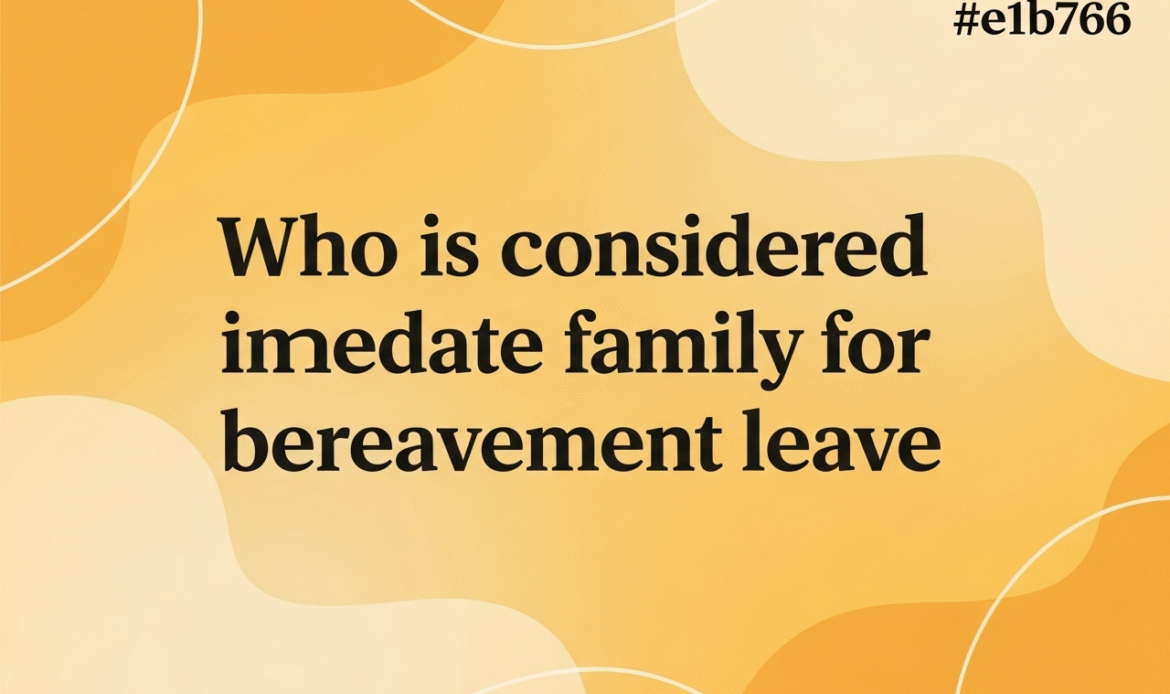Grief is never simple. The days after losing a loved one carry both emotional weight and practical hurdles. For employees, one of the first questions is: what does bereavement leave cover, and who qualifies as immediate family? The answer isn’t always straightforward. It shifts with company policy, state laws, and cultural norms.
In this article, you’ll learn exactly who counts as immediate family for bereavement leave, how definitions differ, what rights workers have, and how employers can build fair policies.
What Is Bereavement Leave
Bereavement leave, also called compassionate leave, gives employees time off to mourn and manage funeral or estate matters. In the U.S., there is no federal law mandating paid leave. Some states, like Oregon and California, set minimums. Most employers create their own rules, deciding how much time is given and who qualifies.
Defining Immediate Family
At its core, immediate family refers to the closest circle of relatives. The most common categories are:
- Parents
- Spouse or domestic partner
- Children (biological, adopted, or step)
- Siblings
These relationships nearly always qualify under bereavement policies.
Extended Definitions
Many companies broaden the scope to cover additional relatives. This can include:
- Grandparents
- Grandchildren
- In-laws (parents-in-law, siblings-in-law)
- Step-relatives
- Legal guardians or wards
Some policies extend further to aunts, uncles, nieces, nephews, or cousins. Cultural practices also influence these decisions, especially in regions where extended family plays a central role.
Employer Flexibility
Employers have the right to define immediate family in their policies. This flexibility means one company may allow three days off for an aunt, while another may only approve unpaid leave for the same situation. Transparent communication between employees and HR is essential to avoid misunderstandings.
Cultural and Regional Differences
In the Philippines, for example, companies often grant two to five days depending on traditions surrounding wakes and funerals. In the U.S., average bereavement leave is three to five days, but it varies by employer. Globally, some countries legally require paid compassionate leave, while others leave it entirely to employer discretion.
Legal Context
While no U.S. federal law mandates bereavement leave, certain states impose requirements. Oregon’s Bereavement Leave Law gives eligible employees up to two weeks off per family death. Illinois requires unpaid leave under the Family Bereavement Leave Act. Policies may also be shaped by union agreements or employment contracts.
Documentation Requirements
Some employers request proof, such as a death certificate, obituary, or funeral program. The goal is to prevent misuse, but for grieving employees, the request can feel invasive. Balancing trust with accountability is key.
Paid vs. Unpaid Leave
Paid leave is not guaranteed. Many employers cover it as part of standard benefits. Others may offer unpaid days, forcing workers to dip into vacation or sick time. Companies that provide paid bereavement leave tend to attract and retain talent more effectively.
Beyond Legal Definitions
Modern workplaces increasingly recognize chosen families. Some policies now cover domestic partners, same-sex spouses, or non-traditional family structures. Employers aiming for inclusivity often expand definitions beyond blood or legal ties.
Duration of Leave
Typical leave is:
- 3–5 days for immediate family
- 1–2 days for extended family
- More time if travel or religious ceremonies are involved
Global comparisons show stark differences. In the UK, bereavement leave is less standardized, while in Japan, leave is structured by kinship degree.
Emotional and Practical Needs
Grief impacts work performance. Employees may need days not only for funerals but also for estate settlement, childcare, or travel. Flexible return-to-work policies and counseling support make transitions smoother.
Employer Best Practices
Employers can ease the burden with:
- Clear written policies
- Training managers to respond with empathy
- Flexibility in work arrangements
- Access to counseling or employee assistance programs
Employee Guidance
Employees should:
- Review company policy in advance
- Communicate with HR as soon as possible
- Provide necessary documentation promptly
- Ask about additional resources if needed
Why Clear Policies Matter
A well-structured bereavement policy reduces confusion, supports morale, and shows genuine care. It signals to employees that the company values humanity alongside productivity.
Current Trends
Recent data shows that younger workers expect broader, more flexible policies. Employers are responding with inclusive definitions and mental health support. Many organizations also reassessed policies during the pandemic, recognizing the wider scope of loss.
Grey Areas in Defining Family
Not every relationship fits neatly into “immediate” or “extended” boxes.
Some employees may be raised by grandparents or older siblings.
Others may rely on guardians, foster parents, or long-term partners without legal recognition.
These situations test the limits of standard policies.
Rigid rules often overlook the actual bonds that matter most in a person’s life.
Companies that adapt to these grey areas earn trust and respect.
Step-Families and Blended Homes
Modern families are complex.
Stepchildren may live full-time with stepparents, creating strong parental bonds.
Yet some policies exclude them unless adoption papers exist.
Blended families should be recognized equally.
Policies that include step-relatives reduce unnecessary stress.
They also align workplace support with real household dynamics.
Guardianship and Legal Dependents
Guardians may act as primary caregivers for minors.
This includes relatives caring for children of deceased siblings or parents.
Bereavement leave policies that acknowledge guardianship reflect social reality.
Legal dependents, such as wards, often play roles equal to children.
Excluding them risks alienating grieving employees.
Forward-thinking policies include dependents without requiring lengthy legal proof.
Chosen Families
Many people rely on close friends who function as family.
LGBTQ+ communities highlight this reality.
Policies that restrict bereavement leave to legal kin ignore chosen families.
Some employers now allow employees to designate a few “family equivalents.”
This creates flexibility and respects diverse living arrangements.
It shows genuine inclusivity beyond legal structures.
Business Costs of Narrow Policies
Restrictive policies harm morale.
Employees forced back to work too soon often underperform.
Stress, absenteeism, and turnover increase.
Replacing an employee costs far more than granting compassionate leave.
A culture of care improves retention.
The business case for broader policies is as strong as the moral one.
International Comparisons
Canada provides job-protected bereavement leave, though pay depends on province.
In New Zealand, employees get three days for close relatives.
India often ties leave rules to corporate policy rather than law.
These global differences influence multinational companies.
Consistent policies across countries can prevent inequality in global teams.
They also set a higher standard for care.
Travel Demands
Funerals may require long-distance travel.
For immigrant families, travel could mean crossing continents.
Three days is rarely enough in such cases.
Some employers add extra unpaid leave for travel.
Others permit flexible work or remote arrangements.
Such options ease pressure while keeping business needs met.
Religion and Rituals
Religious customs shape mourning periods.
Jewish traditions include sitting shiva.
Hindu rituals often last thirteen days.
Employers who ignore rituals risk cultural insensitivity.
Allowing flexible extensions respects diverse traditions.
It also fosters inclusivity in multicultural workplaces.
The Role of Documentation
Death certificates are not always available quickly.
Funeral programs or obituaries may serve as proof.
Employers who demand rigid documentation add unnecessary pain.
Flexible evidence policies strike a better balance.
Trust reduces conflict.
Employees grieving don’t need extra administrative burdens.
Communication and Trust
HR teams must communicate policies clearly.
Vague definitions create confusion.
Employees should know who qualifies without needing to guess.
Transparent policy guides help avoid awkward disputes.
Managers trained in empathy can deliver the message well.
Trust grows when policies feel consistent and fair.
Case Studies
A U.S. tech company recently broadened its definition to include chosen family.
Feedback showed employees valued inclusivity more than the number of leave days.
Morale improved across teams.
In contrast, a retail chain restricted leave only to legal spouses and children.
Employees complained of unfairness.
Turnover rose in the following year.
Real-world outcomes underline the importance of balance.
Legislative Shifts
More states are considering laws similar to Oregon and Illinois.
Employee advocacy groups push for federal recognition.
Momentum suggests gradual expansion of legal protections.
Employers who adapt early stay ahead of regulation.
They also set reputational standards.
A generous policy can be a competitive advantage in hiring.
Employer Resources
Companies can support grief beyond leave.
Employee Assistance Programs (EAPs) often include counseling.
Flexible schedules or work-from-home options help with longer mourning.
Providing resource lists for grief support groups is another step.
Small efforts can reduce isolation.
They show care without significant costs.
Employee Advocacy
Employees should know their rights under local law.
They can push for broader definitions if policies feel outdated.
Collective requests often drive change faster than isolated appeals.
Unions also play a role in negotiating compassionate terms.
Union contracts sometimes expand bereavement benefits.
Awareness is the first step to fair advocacy.
Long-Term Impact on Culture
A workplace that respects grief builds loyalty.
Employees remember who stood by them in their hardest days.
That memory shapes long-term engagement.
Companies that mishandle grief risk lasting damage.
Distrust spreads quickly among staff.
Culture thrives when humanity is prioritized.
Preparing Ahead
Employees can prepare by checking policies before crises occur.
Designating contacts in HR speeds up approval during emergencies.
Awareness prevents last-minute confusion.
Employers can review policies annually.
They should benchmark against industry standards.
Updating policies shows responsiveness to evolving expectations.
Closing Perspective
Bereavement leave policies are more than HR paperwork.
They represent the core values of a company.
Compassion, fairness, and inclusivity define how workplaces respond to grief.
The definition of immediate family continues to expand.
Employers who adapt early strengthen both culture and performance.
Grief deserves recognition that reflects the real shape of families today.
Robert Stewart is a seasoned law blog writer with a passion for translating complex legal concepts into accessible, informative content. With a keen eye for detail and a knack for storytelling, Robert crafts engaging articles that educate and empower readers in the realm of law.
Drawing upon his extensive experience in the legal field, Robert brings a wealth of knowledge to his writing, covering a diverse range of topics including personal injury, family law, criminal defense, and more. His articles combine thorough research with clear, concise language, making them valuable resources for both legal professionals and laypeople alike.


